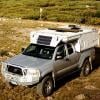
Upgrading from 3-way fridge..
#1

Posted 10 May 2011 - 12:21 AM
I am on the last day of a week long trip with my wife, we have been waaay off the grid camping on BLM land, some incredible places. But the weather has been rough, which is great for photos, but not for the fridge. It is howling wind outside right now and I have to go and make another cardboard partial vent cover, ugh!!!
So bottom line, I am just going to suck it up and add another 85 watt solar panel to the underside of the cabover to get us to at least 170 watts and then get an Engel SR 48 AC/DC fridge/freezer. That is what I think will fit the place the Dometic is now. They also make a 60 quart SR70 in AC/DC but I don't think it will fit.
Anyone else put an Engel fridge in the place of the 1.9 CU Dometic and if so, what size?
Typed from our iPad-2 somewhere in BLM land...
#2

Posted 10 May 2011 - 12:51 AM
With a 125 watt solar panel and dual batteries, I can boondock forever. All of my lights are led also. I am very happy.
You won't be disappointed.
Jeff
#3

Posted 10 May 2011 - 01:06 AM
Special Engel Pricing For WTW Members
Click here to see my ATC Cougar
JayAronowSales.com
(520)579-9610
jayaronow@gmail.com
#4

Posted 10 May 2011 - 01:42 AM
Thanks for the replies!
#5

Posted 10 May 2011 - 04:18 AM
We feel your frustration and will be watching the replies as we are considering doing a similar swap. Our preference is also the front door Engel that would fit in the existing cabinet that holds the small 3-way Dometic. Our question is can we do it without a solar panel? We have duel AGM batteries in the camper. The only electricity we use is LED lights and the heater. No using laptops, watcing DVDs, playing music, charging phones, etc. We rarely if ever have gone more than two nights in one location so the batteries get recharged while driving. So is it possible to switch to an Engel or similar without adding solar?
"Not all who wander are lost. Except Ted, he's usually lost." Dirty Dog
#6

Posted 10 May 2011 - 06:20 AM
So, to size the battery you need to figure out how many amps you will be using in a 24 hour period, or between times of recharging the battery.
The fridge should be easy to find out, most them will give you a 24 hour usage or an hourly usage (which you can calculate up to a 24 hour period). Fridges usually are turned ON the entire 24 hours, other devices may not be.
Sometimes they also list the start up amps, as when going from off to a desired temp, say 34-35 degrees. This is usually a large amount of amps, however, if your food starts out being already cold when you load into the fridge, then amps can be reduced.
On a front door fridge, another small factor is how many times the door is opened or left open for long periods of time, as cold air sinks out the front of the fridge and needs to be replaced, so you'll need a few more amps. Having more cold mass (cold food) in the fridge will reduce amp usage, as the cold mass will help cool the fridge back down quickly (amps can be reduced). This is just an excerise in fine tuning.
- - - - - - - - -
If the manufacturers are not talking amps and instead use WATTS (not a term used in batteries), then the convesion is pretty simple to amps.
Amps = watts / volts
If they say 300 watts for a 24 hour period of time, then... 300 watts / 12 volts = 25 amps, which would be a little over 1 amp per hour in a 24 hour period.
- - - - - - - - -
If you have other 12 VDC devices, see if you can figure them out as well for the number of amps per hour, then multiple the number of hours of usage and sum everything up.
LED lights don't use much and they are usually not ON that long.
The heater does use some amps to run the fan and not much to do the auto ignition.
Figure out the amps, add them into the other things and you'll have the knowledge that you want to size your battery.
- - - - - - - - -
I personally don't like to take any battery below a 50% rating of it's stated amp/hour capacity.
So, if you've got 25 amps of usage between recharging the battery then a 50 amp/hour battery should be OK.
A higher amp/hour rating battery will give you some extra capacity. Maybe a 60 amp/hour or higher battery and I'd feel comfortable.
And, yes, most batteries are well above 12 volts when fully charged. However, figuering everything at 12 volts, should give a little extra wiggle room.
- - - - - - - - -
Using a properly sized solar panel with a quality charge controller will often allow your use of the 12 VDC devices during daylight hours without draining the battery. In fact the solar panel should have enough capacity to operate the 12 VDC devices and charge the battery at the same time. Thus your usage of the devices at night, when the solar panel is dead, is all you have to think about regarding the size of the battery. But, still, extra capacity in a battery is always good to have.
A lot of solar panels actually put out more then 12 volts, often up to 20 volts and are adjusted by the charge controller down to around a 14 volt charge to a battery that changes as the battery achieves full charge. However, to be conservative I always calculate using 12 volts to get my amps/hour charge to the battery. Doing this, will be an error on the safer side of things.
Solar panels are often rated in WATTS, so when thinking about what capacity to buy, do the conversion...
135 watt solar panel... 135 watts / 12 volts = 11.25 amps/hour.
However, solar panels are often not as efficient as stated for lots of various reasons. Amount of sunlight, angle of sun to panel, over enthuastic rating from the manufacturer, etc.
I usually discount the Watt rating of a solar panel to about 70% of the rating. So, the 11.2 amps/hour turns into 7.8 amps/hour.
Need 25 amps to charge up your battery? This one should do it a couple of hours, depending on what kind of charge controller you have and the battery charging profile of that unit.
7.8 amps per hour when the sun is shining should also be enough to operate the fridge I mentioned above with a little extra to charge the battery up at the same time.
Having a charge controller with a multi-function meter (remote or built in) will usually give you a lot more info on your 12 VDC devices than something that just has blinking lights.
#7

Posted 10 May 2011 - 10:57 AM
I found mine for $680.00. I have my door swing set up so I can access with out crawling into the camper.That CR65 is spendy from what I can tell, $1,200+? also, it looks like it is a drawer style, not as easy to get into when top down camping. No interest in the MT45, I am looking for a front door type like the SR48 and SR70. I am hoping to get my solar possibly up to 200 watts since I only have one battery, not sure where I could store a second.
Thanks for the replies!
http://www.smallspacesappliances.com/dometic17cuftfrontloadingrefrigeratorfreezer1224vdc110220ac-1-2.aspx
Jeff
#8

Posted 10 May 2011 - 02:12 PM
A lot of solar panels actually put out more then 12 volts, often up to 20 volts and are adjusted by the charge controller down to around a 14 volt charge to a battery that changes as the battery achieves full charge. However, to be conservative I always calculate using 12 volts to get my amps/hour charge to the battery. Doing this, will be an error on the safer side of things.
Solar panels are often rated in WATTS, so when thinking about what capacity to buy, do the conversion...
135 watt solar panel... 135 watts / 12 volts = 11.25 amps/hour.
However, solar panels are often not as efficient as stated for lots of various reasons. Amount of sunlight, angle of sun to panel, over enthuastic rating from the manufacturer, etc.
I usually discount the Watt rating of a solar panel to about 70% of the rating. So, the 11.2 amps/hour turns into 7.8 amps/hour.
You sorta veered off track here. Lets assume the panel puts out 135watts at 20V like mentioned above, you don't take 135W / 12V * 70% efficiency to get 7.8amps. You're using the efficiency number to make a correction to a fundamental miscalculation. What is really happening is the panel is putting out 6.75amps at 20V, which equals 135watts. However unless you're using a MPPT charge controller when the 20V gets dropped down to your charge voltage (usually about 14V not relevant to the point) you still only have 6.75amps to work with. See the difference?
2022 F350 7.3L; family trailer at the moment and some aluminum stuck together to eventually form another truck camper
#9

Posted 10 May 2011 - 04:17 PM
Probably too late at night for this old brain, I did veer off.
#10

Posted 11 May 2011 - 02:28 AM
Craig K6JGV_________________________ 2004 2500 CTD 4X4 FWC HAWK 1960 CJ5
0 user(s) are reading this topic
0 members, 0 guests, 0 anonymous users

















